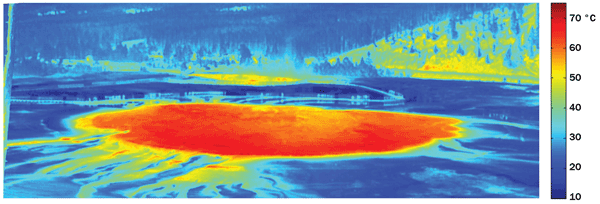Hailed a natural wonderland, Yellowstone National Park is a U.S. treasure. A plethora of geysers – hot springs, in particular – offer a visual feast for sightseers. Alas, the pools have lost a bit of luster through the years, courtesy of make-a-wish coins, rocks and other contaminating debris.
But now scientists from Montana State University and Brandenburg University of Applied Sciences in Germany have been able to visually recreate the original brilliance and optical characteristics of these natural wonders with an optical measurement-based mathematical model that also explains the stunning colors.
The park’s hot springs are naturally “a complicated interplay of underwater vents and lawns of bacteria,” but no mathematical model existed before “that showed empirically how the physical and chemical variables of a pool relate to their optical factors and coalesce in the unique, stunning fashion that they do.”

Thermal image of the Grand Prismatic Spring at Yellowstone National Park. Photo courtesy of Joseph Shaw, MSU.
The new model, featured in the OSA journal Applied Optics (doi: 10.1364/AO.54.00B128), is pretty straightforward, according to Joseph Shaw, a professor at MSU and director of its Optical Technology Center. “You can explain some very beautiful things with relatively simple models.”
Shaw and fellow researchers Paul Nugent, a MSU PhD candidate, and Michael Vollmer, of Brandenburg University, began the study in 2012 during a visit to Yellowstone. It began as a project just for fun, but they soon discovered that not much scientific literature existed on the subject – this prompted them to jump in.
“We didn’t start this project as experts on thermal pools,” Shaw said. “We started this project as experts on optical phenomena and imaging and so we had a lot to learn.”
The researchers took measurements at many of the springs throughout the park using handheld spectrometers, digital SLR cameras for visible images, and long-wave IR thermal imaging cameras to gauge water temperature. The one-dimensional model uses light propagation, and has allowed the researchers to account for each pool’s spectral reflection due to microbial mats, optical absorption and scattering of water, as well as the incident solar and diffuse skylight conditions present when the measurements were taken.
The resulting renderings of the pools’ original coloring are “strikingly similar to actual photographs.” For instance, the researchers have been able to simulate the glory days (1880s to 1940s) of the Morning Glory Pool. Its temperatures were significantly higher back then, and the water appeared a deep, uniform blue. However, decades of debris accumulation has essentially lowered the pool’s overall temperature and prompted a change in microbial mat composition, causing the water to take on an orange-yellow-green hue.
The new mathematical model could ultimately assist in environmental studies and monitoring.
“Our [work] describes a very simple, one-dimensional model that gives the first clue if you really want to do more,” Vollmer said.